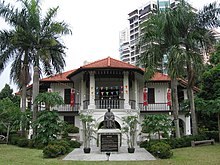The Sun Yat Sen Nanyang Memorial Hall, also known as Wan Qing Yuan, and formerly as the Sun Yat Sen Villa, is a two-storey colonial style villa in Balestier, Singapore. The villa is now a museum commemorating Sun Yat Sen (1866–1925), the founding father of the Republic of China who visited Singapore nine times between 1900 and 1911.
Located at 12 Tai Gin Road in Balestier, the villa occupies an area of approximately 3,120 square metres and played a crucial role in the 1911 Xinhai Revolution by serving as the Tongmenghui's base in Nanyang (Southeast Asia) in the early 20th century.
The villa was designed in 1900 and built in 1901by Boey Chuan Poh (梅春辅; 1874-1926 ), a businessman who owned the newspaper Union Times. The villa was rumoured to be a home for his mistress Bin Chan, hence it was called "Bin Chan House". In 1902, Boey sold the villa for $10,800 to Lim Ah Siang (林亚相; 1866-1925), the towkay of a timber business in Johor and Singapore and the leader of the Teochew secret society Ngee Heng Kongsi. The building was constructed in a classical colonial style, featuring ornate arched windows and dooors, eaves decorated with floral patterns, and movable louvred windows.
In 1905, rubber magnate Teo Eng Hock (张永福; 1872–1957) – a great-granduncle of Singapore's Deputy Prime Minister Teo Chee Hean – bought the villa for his mother, Tan Poh Neo, as a place of retirement. He renamed it "Wan Qing Yuan", a name inspired by a line from a Tang dynasty poem by Li Shangyin. In July 1905, Sun Yat Sen met Teo, Tan Chor Lam (陈楚南; 1884–1971) and Lim Nee Soon in Singapore through his close friend, Yau Lit, while en route to Europe from Japan. In April 1906, when Sun visited Singapore again, Teo offered his villa for use as the Tongmenghui's headquarters in Southeast Asia. At the villa, the Tongmenghui planned numerous uprisings and fundraising activities leading to the 1911 Xinhai Revolution, which ended imperial rule in China under the Qing dynasty. Three uprisings of the Xinhai Revolution – Chaozhou Uprising (May 1907), Zhennanguan Uprising (December 1907), and Hekou Uprising (April 1908) – were planned in the villa. Teo and his wife, Tan Sok Jee, sewed the flag of the Republic of China in the villa.
...
Wikipedia

